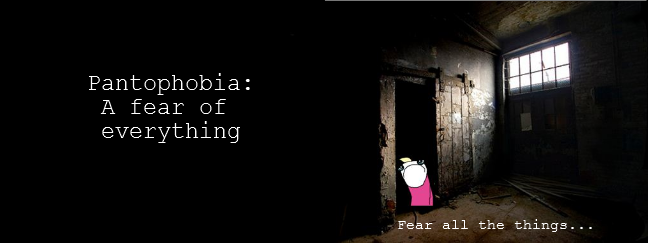Do you avoid going out, or staying in social situations for fear of something bad happening? Do you often get the feeling, why am I so scared of everything? If so, you may be experiencing pantophobia. This article will explore what pantophobia is, the different types and degrees, how it affects relationships and work, as well as some tips on how to cope.
Contents
Understanding Pantophobia

Pantophobia is the fear of everything. It’s a general, all-encompassing fear that can be directed toward anything in the world. People with pantophobia may be afraid of specific things or situations, but the fear is always there lurking in the background.
There is no one definition for pantophobia, as it can manifest in different ways depending on the person. For some, it’s a fear of anything and everything. For others, it may be a fear of specific things such as blood, heights, or spiders. The fear can also be directed toward situations, such as being in crowded places or traveling.
Types of Pantophobia
Pantophobia is a general term for fear of everything, but there are actually different types that can be categorized based on what people fear. Some of the most common types of pantophobia include:
- Technophobia – Fear of technology
- Entomophobia – Fear of insects
- Sociophobia – Fear of social situations
- Pathophobia – Fear of disease or germs
- Mysophobia – Fear of germs
- Anthropophobia – Fear of other people
- Arachnophobia – Fear of spiders or spider webs
- Diprosopus – Fear of having two faces
- Dysmorphophobia – Fear of deformity
- Claustrophobia – Fear of confined spaces
- Acrophobia – Fear of heights
- Katagelophobia – Fear of being ridiculed
- Trypophobia – Fear of irregular patterns
- Agoraphobia – Fear of open spaces
- Aquaphobia – Fear of water
- Autophobia – Fear of being alone
- Cacophobia – Fear of ugliness.
- Emetophobia – Fear of vomiting
- Ergophobia – Fear of work
- Glossophobia – fear of speaking in public
- Hemophobia – Fear of blood
- Monophobia – Fear of being alone
- Nyctohylophobia – Fear of dark woods
- Ophidiophobia – Fear of snakes
- Agoraphobia – Fear of open spaces
- Stasiphobia – Fear of standing
- Arachnophobia – Fear of speed
- Kinetophobia – Fear of movement
- Claustrophobia – Fear of closed-in spaces
- Octophobia – Fear of the number eight
- Sociophobia – Fear of social situations
- Pathophobia – Fear of disease or illness
- Epistemophobia – Fear of knowing things
- Gerontophobia – Fear of old people or aging
- Panthophobia – Fear of suffering and disease
- Lilapsophobia – Fear of tornadoes and hurricanes
- Globophobia or Chrematophobia – Fear of money
- Pantheophobia – Fear of “everything in god’s creation”
- Aphenphosmphobia – Fear of being touched by others
- Nomophobia – Fear of being without a mobile phone or access to the internet
Degrees of Pantophobia
The degree of phobia is measured by its intensity, and there are three levels.
- First-Degree: It has mild anxiety that lasts for a short period of time.
- Second-Degree: People experience moderate fear and anxiety which can last longer than first-degree pantophobia.
- Third Degree: It is the most severe form of pantophobia where people experience intense fear and anxiety, which can last a long time.
Symptoms Of Pantophobia

People with pantophobia are afraid of suffering and disease, and they may avoid going to the doctor or dentist because of it. This can lead to them having poor health habits and fear of other physical procedures as well. The symptoms include:
- Mental anxiety
- Avoidance of anything that could trigger the fear
- Physical tension in your body such as sweating, trembling hands or legs, racing heart, and dizziness
- Conditioning or associations with other fears. For example, a person who is afraid of germs may start to avoid all public places because they are afraid of getting sick
DSM And Its Criteria On Pantophobia
The Diagnostic and Statistical Manual of Mental Disorders, Fifth Edition (DSM-V) is the handbook used by mental health professionals in the United States to diagnose mental disorders. It contains all sorts of information about mental health conditions, including their symptoms and how they’re treated. The DSM-V has nine criteria for diagnosing phobias like pantophobia. Five or more must be present to make a diagnosis according to these guidelines:
- Fear is persistent (lasting at least six months).
- Exposure causes a significant amount of anxiety or distress.
- The fear is not caused by the use of drugs or medications.
- The fear is not caused by a medical condition (such as diabetes).
- Fear is disproportionate to the actual risk posed by the feared object or situation.
- The fear interferes with normal daily activities, such as going to work or school, socializing, or enjoying life.
- The fear is not better explained by another mental disorder (such as Generalized Anxiety Disorder or a specific phobia of an animal, like spiders).
- Fear doesn’t stem from another mental disorder. The person has experienced it on its own without any other symptoms first occurring, which might indicate an underlying problem like depression or anxiety that needs treatment before tackling this one specifically.
Risk Factors of Pantophobia
There are some risk factors that can increase a person’s chances of developing pantophobia. They include:
Having a family history of mental health conditions: If you have a parent or sibling who has been diagnosed with a mental health condition, you’re more likely to develop one too.
Using drugs or alcohol regularly: Using substances can have negative effects on your mental health, which could increase the risk of developing pantophobia.
Experiencing a traumatic event: If you’ve experienced something really scary or dangerous, like being in a car accident or assault, it can increase your risk of developing pantophobia.
Having poor physical health habits: People who don’t take care of their physical health are also more at risk for developing pantophobia. This includes not eating well, not getting enough exercise, and smoking or drinking too much.
Living with stress or anxiety on a regular basis: If you constantly have to worry about everything, it could be a sign that something isn’t right. This can increase your risk factors for pantophobia.
Living With Pantophobia

People who have pantophobia (why am I so scared of everything) often live in constant fear. This can lead to a lot of anxiety and distress. They may avoid socializing, going to work or school, or participating in any activities they used to enjoy. Some people even have trouble leaving their homes because they’re so afraid of what might happen.
Ill-effects On Relationships
Pantophobia can also have a negative impact on relationships. People with pantophobia may find that it’s difficult to be around other people because they don’t feel safe when someone else is near them or if there are too many people in the same room at once, even though this might not seem like an irrational fear for some folks!
Pantophobia can also affect romantic relationships. In one case study, a woman with pantophobia was so afraid of her husband’s touch that she would run away from him whenever he tried to hold hands or hug her. This ultimately led them down a path towards separation and divorce.
Ill-effects On Work
Pantophobia can also have negative effects on work performance. People with pantophobia may find it difficult to concentrate or be productive when they’re at work. They might also feel anxious and stressed all the time, which can lead to burnout.
Ill-effects On Social Life
Pantophobia can also have a negative impact on social life. People with this fear may avoid socializing altogether or only participate in activities with people they know and feel comfortable around. This can lead to a feeling of isolation and loneliness.
Pantophobia And Mental Health
People with pantophobia may also be at an increased risk for developing other mental health conditions, such as anxiety, depression, or post-traumatic stress disorder (PTSD).
Coping With Pantophobia
There are a few different ways that people can cope with pantophobia.
- One way is to try and face your fears head-on. This might mean slowly introducing yourself to new situations or people until you feel more comfortable. You could also talk to a therapist, who can help you understand and manage your fear.
- Another way to cope is by developing a self-care routine. This could include things like exercise, meditation, journaling, or spending time outdoors. It’s important to find activities that make you feel good and help you relax.
Practical Tips
If you have pantophobia, there are some practical tips that might be able to help you feel more comfortable in certain situations.
- For example, if you’re afraid of large crowds, try to find a spot near the back or at the edge of the room.
- If you’re afraid of flying, see if you can book a seat over the wings or by the emergency exit.
- And if you’re afraid of spiders, try to keep a distance between you and the critter.
Lifestyle Tips
In addition to practical tips, it’s also important to have a healthy lifestyle. This includes getting enough exercise and eating nutritious foods.
- Exercise releases endorphins, which are hormones that can help improve mood and reduce stress.
- And nutritious foods provide the body with essential vitamins and minerals that can help boost energy levels and improve mood.
Diet Tips
In addition to exercise, it’s also important to have a healthy diet. This means eating plenty of fruits, vegetables, whole grains, and lean protein.
- Fruits and vegetables are rich in antioxidants, which can help protect the body from damage caused by free radicals.
- Whole grains are a good source of fiber, which can help regulate digestion and prevent constipation.
- And lean protein is beneficial because it helps keep blood sugar levels stable, which can help reduce anxiety and stress.
Talking To a Professional
If you think you might have pantophobia, it’s important to talk to a professional. They can help you understand your symptoms and provide treatment options that are right for you.
A therapist will listen carefully to what’s been going on in your life and ask about any other issues or concerns that could be contributing factors such as depression, anxiety, or trauma.
Treatment Options
There are a few different treatment options for pantophobia (why am I so scared of everything).
- Some people may benefit from therapy, which can help them understand and manage their fear.
- Others may find relief from medications such as antidepressants or antianxiety drugs.
- And some people may find success with therapies such as exposure therapy or cognitive-behavioral therapy (CBT).
Therapies
There are a few different therapies that people with pantophobia (why am I so scared of everything) may find helpful.
Exposure Therapy
One therapy is exposure therapy, which involves gradually exposing someone to the things they’re afraid of. This can help them learn that the feared object or situation isn’t actually as bad as they thought it was.
Cognitive-behavioral Therapy (CBT)
Another therapy is cognitive-behavioral therapy (CBT), which helps people change the way they think about things that scare them. CBT can help reduce anxiety and improve mood.
Medications
There are a few different medications that people with pantophobia (why am I so scared of everything) may find helpful.
- Antidepressants
- Antianxiety Drugs
- Antipsychotics
- Benzodiazepines
- Beta-blockers
These medications may help in combination with other treatments such as therapy or exposure therapy. These drugs can help reduce anxiety and improve mood. They’re usually taken once or twice a day. But it may take up to four weeks for them to start working properly.
Supporting Someone Through It
If someone you know is struggling with pantophobia (why am I so scared of everything), there are things you can do to help.
- First, it’s important to be supportive and understanding. Let them know that you’re there for them and that they can talk to you about anything.
- Second, try not to push them to do things they’re afraid of. Respect their limits and be patient as they work through their fear.
- Third, offer help when you can. If they need a ride somewhere, or if they want you to come over and watch TV with them, let them know that you’re happy to help.
Hearing Experts On Pantophobia
There are a few experts on pantophobia who can offer more information about the condition (why am I so scared of everything).
Dr. Jerry Kennard is a psychologist who specializes in anxiety disorders. He has written a book about pantophobia called “Panic Attacks: A Comprehensive Guide to Overcoming Panic Disorder and Agoraphobia”.
Dr. Michael Tompkins is a psychologist who specializes in anxiety and OCD disorders. He has written a book about pantophobia called “Fear: A Complete Guide to Its Causes, Symptoms, and Treatments”.
Brain Activity During Pantophobia
There is some research that has looked at brain activity during pantophobia. According to one study, people with pantophobia had more activity in the left amygdala than those without. The amygdala is a part of the brain that processes emotions such as fear and anxiety.
Case Studies
There are a few case studies that have looked at people with pantophobia.
One study looked at three patients who had this condition. Two of these patients had panic disorder and one patient did not.
The researchers found that those who had panic disorder had more activity in their left amygdala than those without it, which may explain why they were more likely to experience fear and anxiety.
Another study looked at two patients with pantophobia. They found that both of these patients had a history of trauma in their lives, which might have contributed to their symptoms.
Conclusion
Pantophobia is a fear of everything. It can be an outcome of anxiety or trauma. And it can lead to symptoms such as panic attacks, stress, and anxiety. There are a few different treatment options available. Including therapy, medication, and exposure therapy. If someone you know is struggling with pantophobia, there are things you can do to help. You can be supportive and understanding, and you can offer help when you can. There are also a few experts on pantophobia who can offer more information about the condition.
A Word From Therapy Mantra
Your mental health — Your psychological, emotional, and social well-being — has an impact on every aspect of your life. Positive mental health essentially allows you to effectively deal with life’s everyday challenges.
At TherapyMantra, we have a team of therapists who provide affordable online therapy to assist you with issues such as depression, anxiety, stress, workplace Issues, addiction, relationship, OCD, LGBTQ, and PTSD. You can book a free therapy or download our free Android or iOS app.


